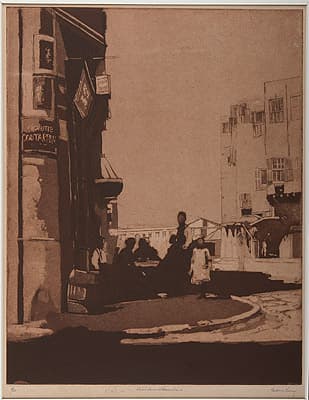
Sydney
LONG
Australia
1871
–
London
1955
England, Europe 1910-21; Australia 1921- 22; England 1922-25; Australia 1925-52; England from 1952
35.4 (h) x 27.8 (w) cm
signed ‘Sydney Long’ lower right, titled lower centre and inscribed ‘1/60 lower left below plate mark New England Regional Art Museum, Armidale, anonymous gift 1942
Street scene, Alexandria captures the cosmopolitan atmosphere of the thriving Egyptian port city. In this impression, printed in brown ink, the airy expanse of sky is given warmth by the application of plate tone, while the bleached facades of the buildings in the background reflect the crisp white light of the Mediterranean sun. Men wearing traditional turbans and the Ottoman tarboosh, or fez, sit enjoying small cups of coffee or sweet tea as a young boy and a girl in a white pinafore turn towards the artist as he sketched the scene.
The area depicted is most likely the ‘Frankish’, or European, quarter, which centred on Muhammad Ali Square. Alongside the principle consulates, commercial and municipal buildings, there were also merchant’s houses, cafes, and hotels. The corner of the building at the left of Long’s composition bears signs in Arabic and English, with the central scene pooled in shadowy washes of aquatint, which are also used to describe the sweeping curve of the pavement. An inky band at the very bottom of the work creates a sense of distance between the viewer and the Eastern scene.
Though by the early 1920s Alexandria was viewed as ‘Europeanised’, travellers continued to enjoy the city’s offerings, often stopping for a few nights before returning to their sea voyages, or setting off for Cairo or journeys up the Nile. When Long’s steamer called at the Egyptian port as part of its route towards Europe, he and his fellow travelling companions would have been met by a smaller boat to be ferried to the quayside. With perhaps only a brief time for sightseeing, the artist may have followed the advice offered by popular guidebooks that directed visitors to explore the city’s bazaars, which were considered its most ‘Oriental’ feature, as well as Pompey’s Pillar, the Alexandria Museum and catacombs.
Emma Kindred
Street scene, Alexandria captures the cosmopolitan atmosphere of the thriving Egyptian port city. In this impression, printed in brown ink, the airy expanse of sky is given warmth by the application of plate tone, while the bleached facades of the buildings in the background reflect the crisp white light of the Mediterranean sun. Men wearing traditional turbans and the Ottoman tarboosh, or fez, sit enjoying small cups of coffee or sweet tea as a young boy and a girl in a white pinafore turn towards the artist as he sketched the scene.
The area depicted is most likely the ‘Frankish’, or European, quarter, which centred on Muhammad Ali Square. Alongside the principle consulates, commercial and municipal buildings, there were also merchant’s houses, cafes, and hotels. The corner of the building at the left of Long’s composition bears signs in Arabic and English, with the central scene pooled in shadowy washes of aquatint, which are also used to describe the sweeping curve of the pavement. An inky band at the very bottom of the work creates a sense of distance between the viewer and the Eastern scene.
Though by the early 1920s Alexandria was viewed as ‘Europeanised’, travellers continued to enjoy the city’s offerings, often stopping for a few nights before returning to their sea voyages, or setting off for Cairo or journeys up the Nile. When Long’s steamer called at the Egyptian port as part of its route towards Europe, he and his fellow travelling companions would have been met by a smaller boat to be ferried to the quayside. With perhaps only a brief time for sightseeing, the artist may have followed the advice offered by popular guidebooks that directed visitors to explore the city’s bazaars, which were considered its most ‘Oriental’ feature, as well as Pompey’s Pillar, the Alexandria Museum and catacombs.
Emma Kindred
Street scene, Alexandria captures the cosmopolitan atmosphere of the thriving Egyptian port city. In this impression, printed in brown ink, the airy expanse of sky is given warmth by the application of plate tone, while the bleached facades of the buildings in the background reflect the crisp white light of the Mediterranean sun. Men wearing traditional turbans and the Ottoman tarboosh, or fez, sit enjoying small cups of coffee or sweet tea as a young boy and a girl in a white pinafore turn towards the artist as he sketched the scene.
The area depicted is most likely the ‘Frankish’, or European, quarter, which centred on Muhammad Ali Square. Alongside the principle consulates, commercial and municipal buildings, there were also merchant’s houses, cafes, and hotels. The corner of the building at the left of Long’s composition bears signs in Arabic and English, with the central scene pooled in shadowy washes of aquatint, which are also used to describe the sweeping curve of the pavement. An inky band at the very bottom of the work creates a sense of distance between the viewer and the Eastern scene.
Though by the early 1920s Alexandria was viewed as ‘Europeanised’, travellers continued to enjoy the city’s offerings, often stopping for a few nights before returning to their sea voyages, or setting off for Cairo or journeys up the Nile. When Long’s steamer called at the Egyptian port as part of its route towards Europe, he and his fellow travelling companions would have been met by a smaller boat to be ferried to the quayside. With perhaps only a brief time for sightseeing, the artist may have followed the advice offered by popular guidebooks that directed visitors to explore the city’s bazaars, which were considered its most ‘Oriental’ feature, as well as Pompey’s Pillar, the Alexandria Museum and catacombs.
Emma Kindred
